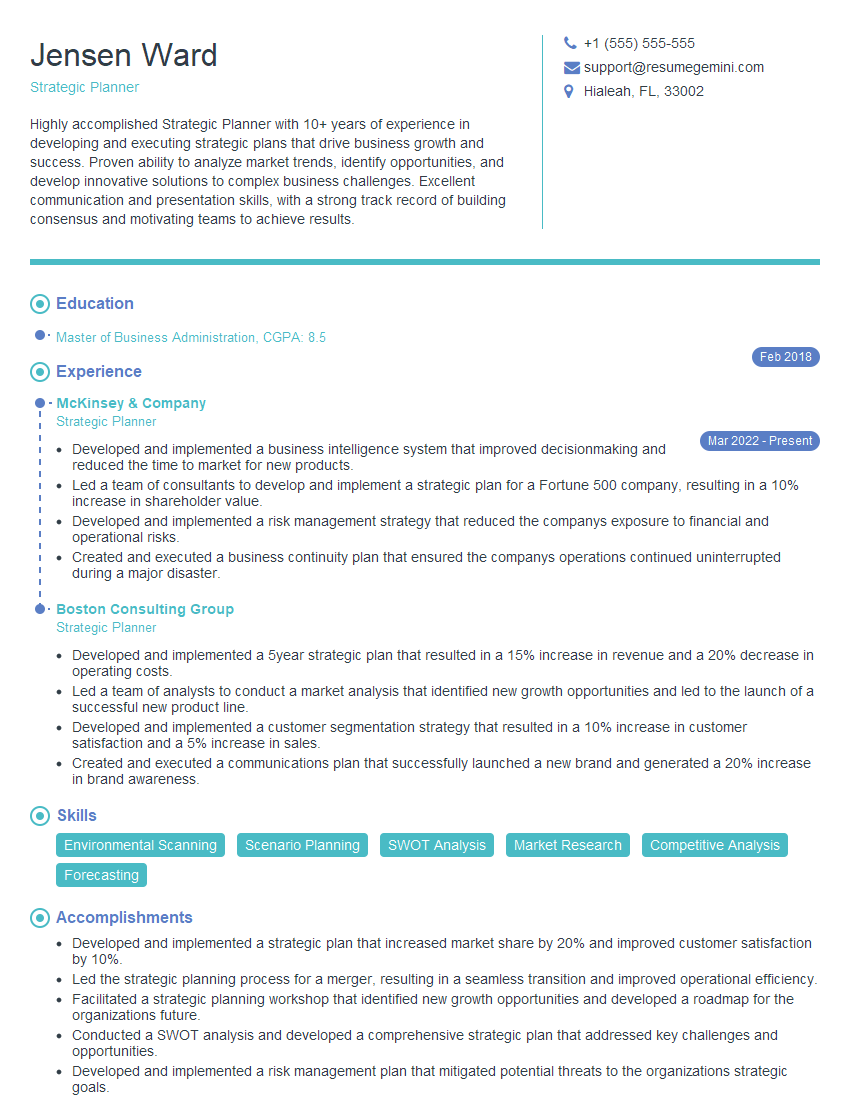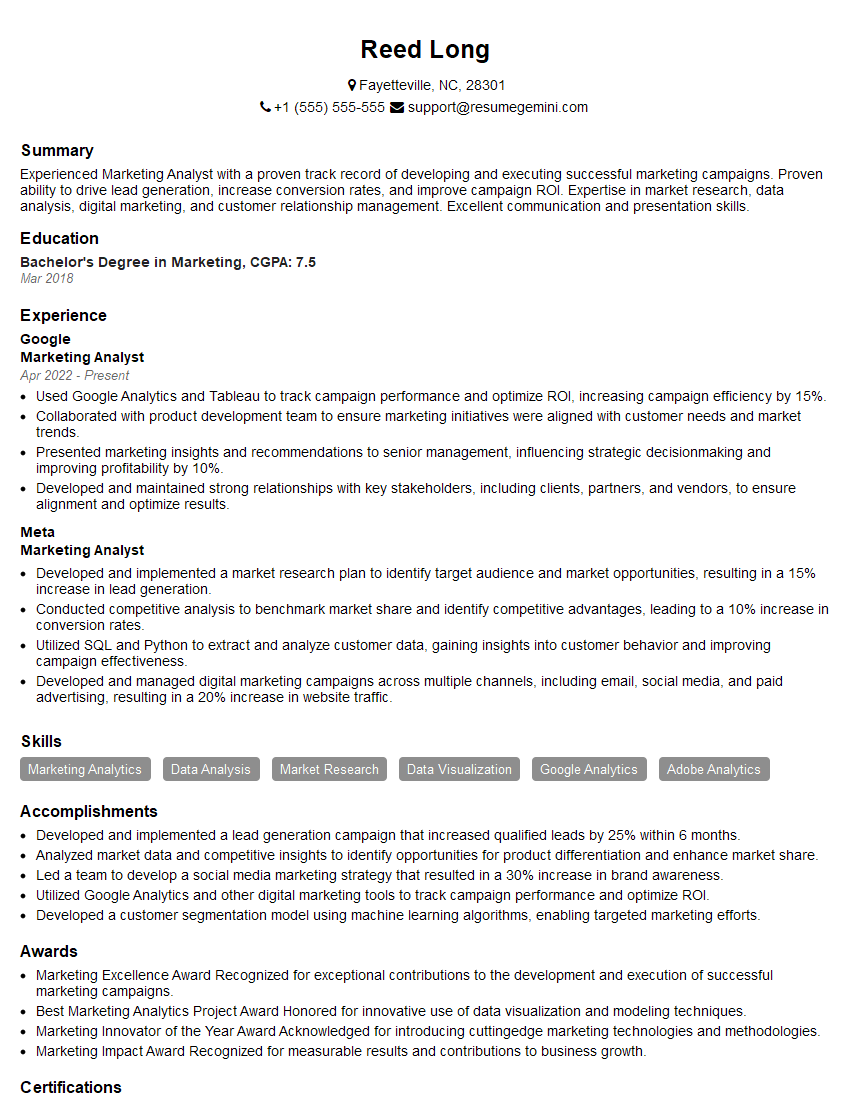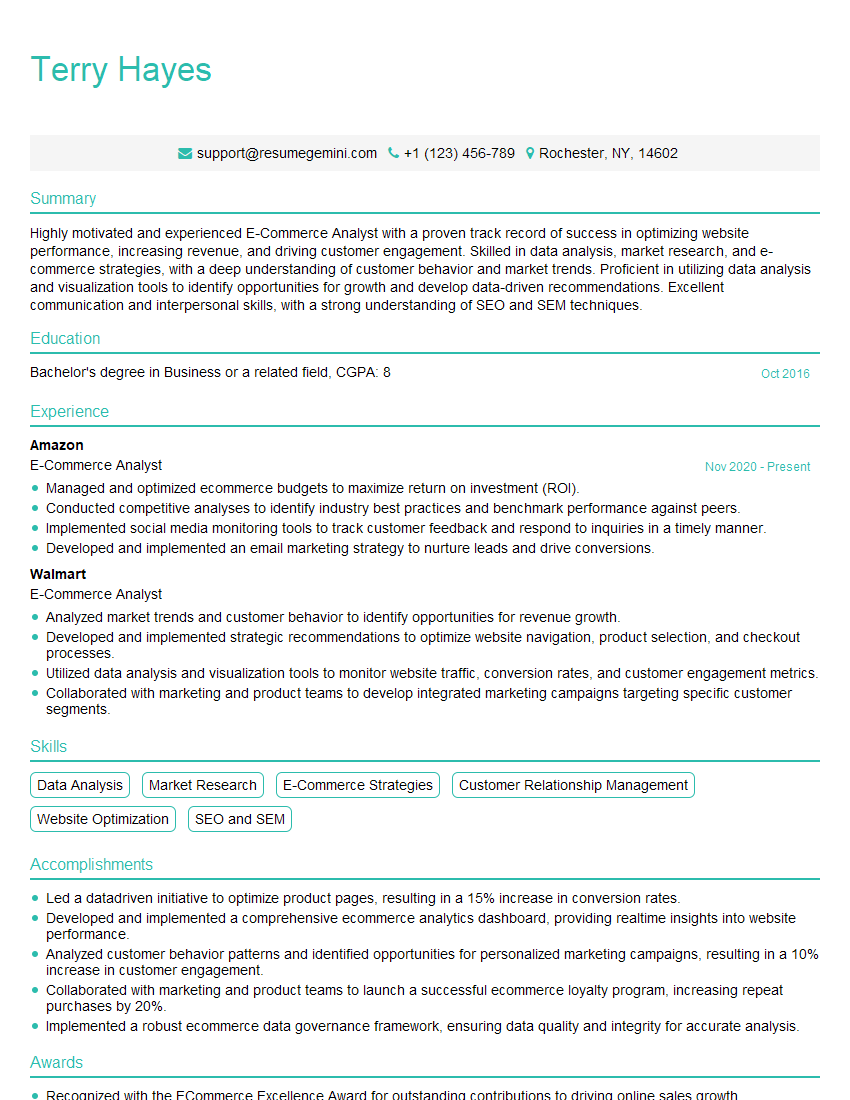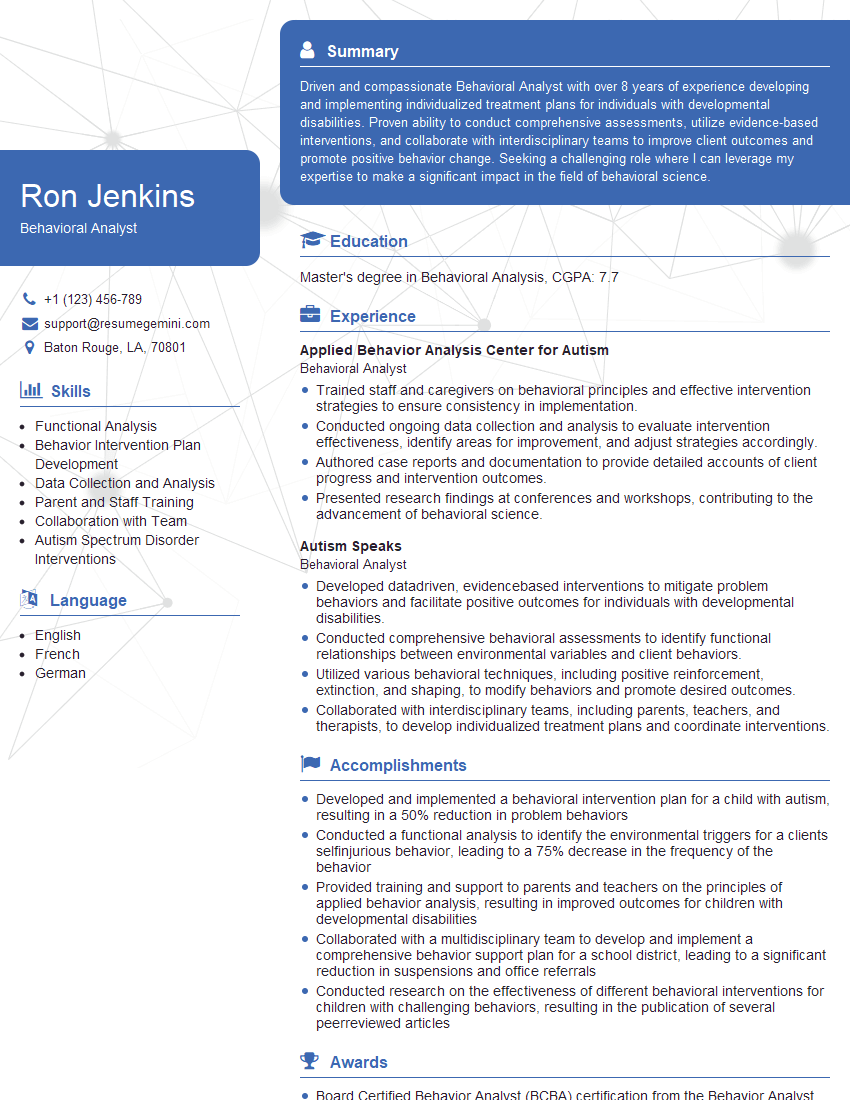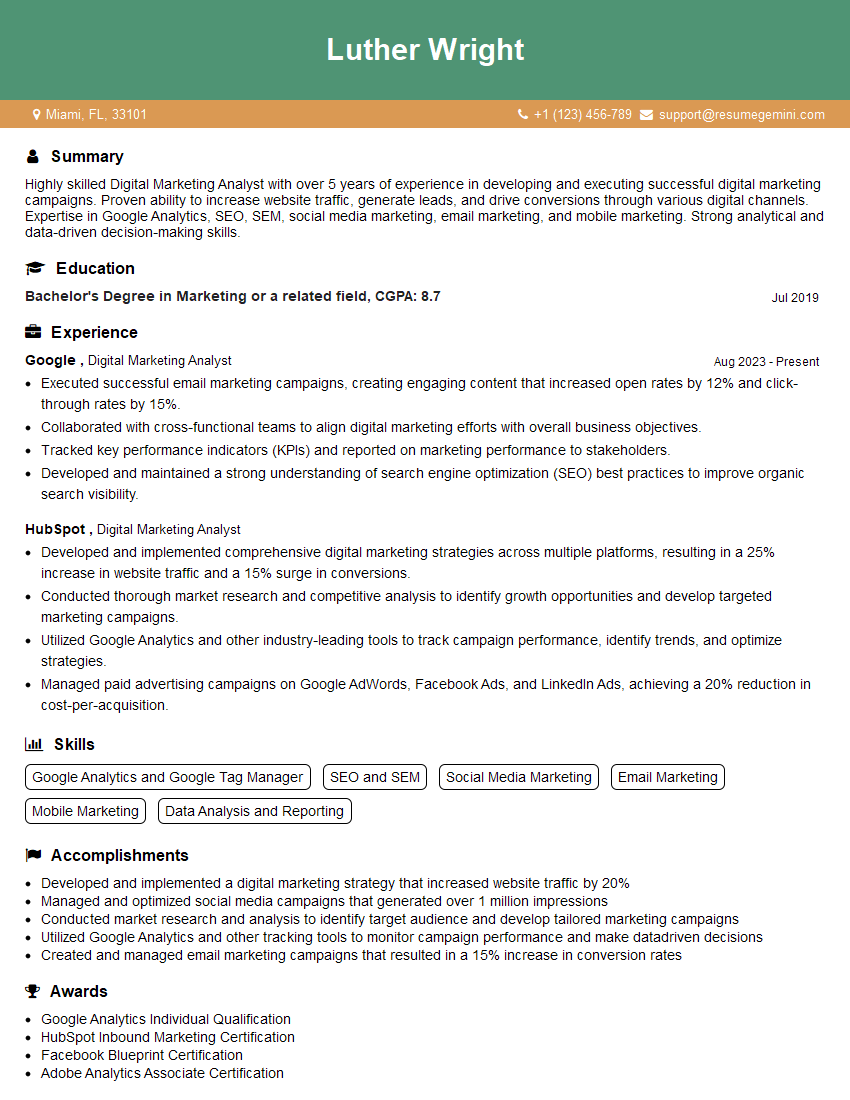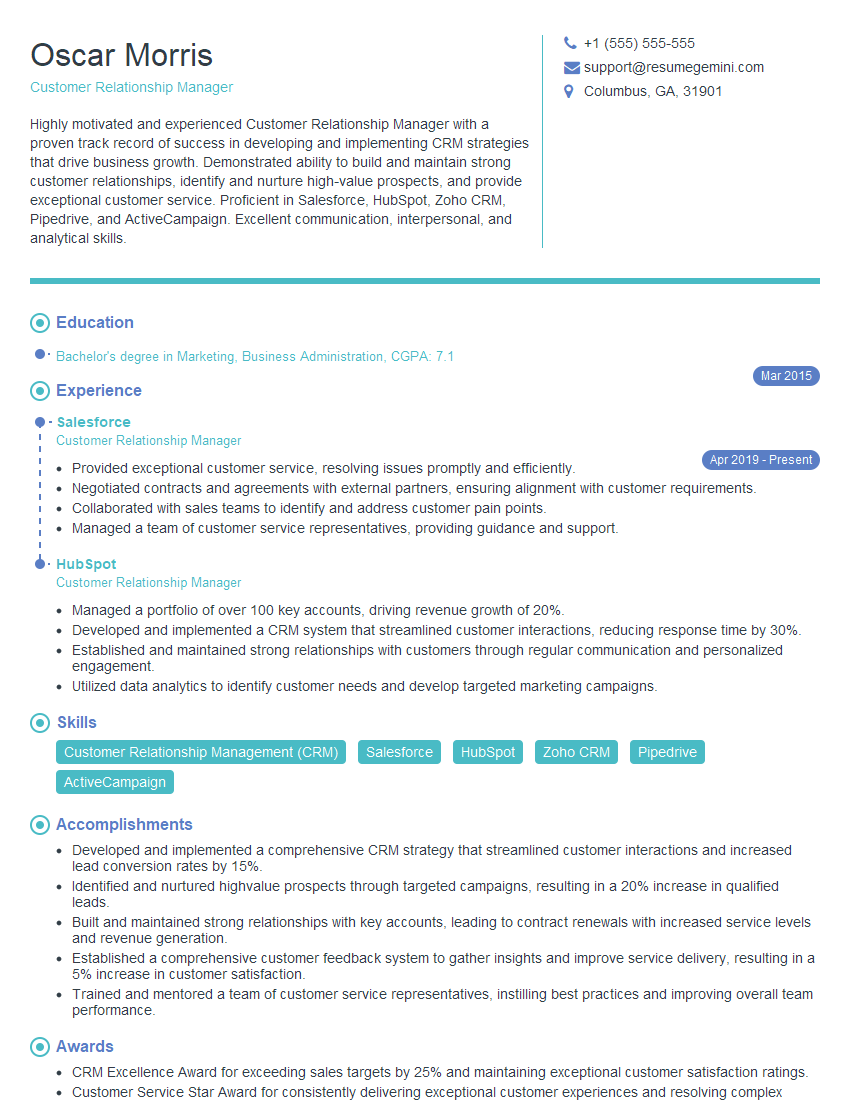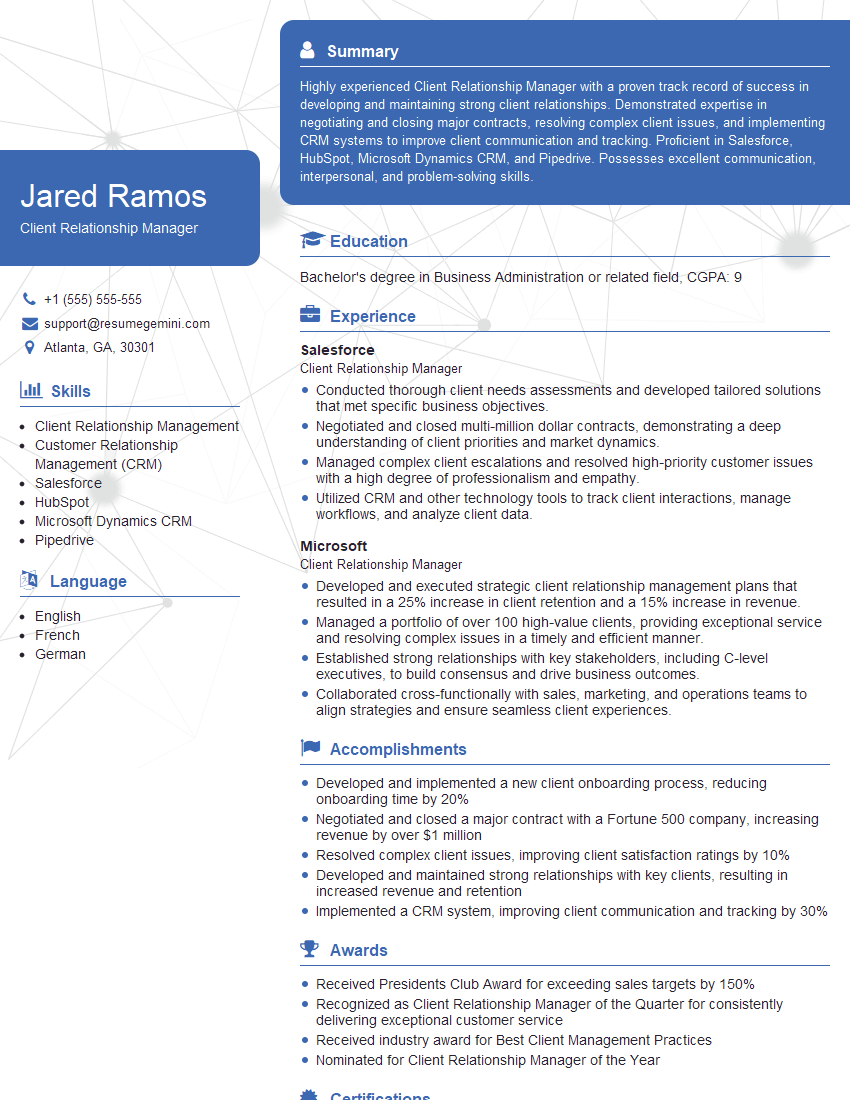Feeling uncertain about what to expect in your upcoming interview? We’ve got you covered! This blog highlights the most important Customer Profiling interview questions and provides actionable advice to help you stand out as the ideal candidate. Let’s pave the way for your success.
Questions Asked in Customer Profiling Interview
Q 1. Explain the process of developing a customer profile.
Developing a customer profile is like creating a detailed sketch of your ideal customer. It involves systematically gathering and analyzing information to understand their demographics, behaviors, preferences, and needs. This process is iterative, meaning it’s constantly refined as you learn more.
The process typically follows these steps:
- Define Objectives: Clearly state what you want to achieve with the customer profiles. For example, are you aiming to personalize marketing campaigns, improve customer service, or develop new products?
- Data Collection: Gather relevant data from various sources (discussed in the next question).
- Data Cleaning and Preparation: Cleanse and standardize the data to ensure accuracy and consistency. This involves handling missing values, correcting errors, and transforming data into a usable format.
- Data Analysis: Analyze the data to identify patterns, trends, and insights. Techniques like segmentation and clustering can be used here.
- Profile Creation: Develop detailed profiles that encapsulate the key characteristics of different customer segments. These profiles should be actionable and guide decision-making.
- Validation and Refinement: Test the accuracy and usefulness of the profiles. Refine them based on feedback and new data.
For example, a clothing retailer might create profiles for ‘Budget-conscious young adults,’ ‘Luxury-seeking professionals,’ and ‘Family-oriented shoppers,’ each with distinct characteristics that inform marketing and product development strategies.
Q 2. What are the key data sources you would utilize for building customer profiles?
The data sources for building robust customer profiles are diverse and depend heavily on the business and its available resources. Think of it like piecing together a puzzle – each source contributes a different piece of the picture.
- Transaction Data: Purchase history, frequency, value, and product categories reveal buying patterns and preferences.
- Website Analytics: Website traffic, pages visited, time spent on site, and conversion rates offer insights into online behavior.
- CRM Data: Customer relationship management systems hold a wealth of information about interactions, support tickets, and communication history.
- Social Media Data: Publicly available information from social media platforms can reveal interests, opinions, and lifestyle choices (with appropriate ethical considerations).
- Surveys and Feedback: Directly gathering customer opinions through surveys, feedback forms, and focus groups provides valuable qualitative data.
- Marketing Campaign Data: Analyzing responses to marketing campaigns helps determine effectiveness and identify segments that are most responsive.
- Third-Party Data: Demographic data, lifestyle information, and purchase behavior data from external providers can enhance profiling (with appropriate privacy safeguards).
For instance, a coffee shop could combine transaction data showing frequent purchases of lattes with website analytics revealing high engagement with their loyalty program to identify their most loyal customers.
Q 3. How do you identify and segment customer personas?
Identifying and segmenting customer personas is the art of turning data into actionable insights. We’re essentially creating archetypes representing groups of customers with similar characteristics.
The process usually involves:
- Data Analysis: Use clustering algorithms or manual analysis to group customers based on similarities in their data points.
- Persona Development: Create detailed descriptions for each segment, including demographics, psychographics (values, attitudes, lifestyles), behavioral patterns, and needs. Give each persona a name to make it relatable.
- Validation: Validate the personas by checking if they align with real-world customer behavior and feedback.
For example, a car manufacturer might identify personas like ‘Eco-conscious commuter,’ ‘Adventure-seeking family,’ and ‘Luxury-oriented executive,’ each with unique preferences influencing car features, marketing messaging, and sales strategies.
Tools like R or Python with libraries such as scikit-learn can be used for advanced clustering techniques. For simpler cases, manual segmentation based on readily available data is also effective.
Q 4. Describe your experience with different customer segmentation techniques (e.g., demographic, behavioral, psychographic).
I have extensive experience using various customer segmentation techniques. Each offers a unique lens to understand customer behavior:
- Demographic Segmentation: This classic approach divides customers based on observable characteristics like age, gender, location, income, education, and family size. It’s a good starting point but can be overly simplistic.
- Behavioral Segmentation: This focuses on customer actions, such as purchase history, website activity, engagement with marketing campaigns, and customer service interactions. It offers a more dynamic and insightful view of customer behavior. Examples include categorizing customers as ‘high-value,’ ‘loyal,’ or ‘at-risk’.
- Psychographic Segmentation: This delves into customers’ psychological characteristics, values, attitudes, interests, and lifestyles. It’s more complex to obtain but allows for a deeper understanding of customer motivations and preferences. Examples include segmenting customers as ‘environmentally conscious,’ ‘tech-savvy,’ or ‘price-sensitive’.
In practice, I often combine these techniques for a holistic view. For instance, a bank might segment customers based on demographics (age, income) and behavior (transaction frequency, loan applications) to create targeted financial products and marketing campaigns.
Q 5. How do you handle incomplete or inaccurate customer data?
Handling incomplete or inaccurate data is crucial for the reliability of customer profiles. It’s like building a house on a shaky foundation – the whole structure could collapse.
My approach involves:
- Data Imputation: For missing values, I use appropriate imputation techniques based on the data type and context. This might involve replacing missing values with the mean, median, or mode, or using more advanced methods like K-Nearest Neighbors.
- Data Cleaning: I identify and correct inconsistencies and errors in the data. This might involve standardizing formats, removing duplicates, and addressing outliers.
- Data Validation: I use various techniques to validate data accuracy, such as comparing data from multiple sources, using data quality rules, and cross-referencing with other databases.
- Data Filtering: Sometimes it’s best to remove data points that are too unreliable or have too many missing values rather than trying to impute or correct them.
For instance, if a customer’s address is missing, I might try to retrieve it from other sources like their shipping information or social media profiles. If I cannot verify its accuracy, I might exclude that data point from certain analyses.
Q 6. What are the ethical considerations involved in customer profiling?
Ethical considerations are paramount in customer profiling. It’s about respecting customer privacy and avoiding discriminatory practices. It’s like handling personal information with the care it deserves.
Key considerations include:
- Data Privacy: Adhering to data privacy regulations (like GDPR, CCPA) is essential. This means obtaining explicit consent, ensuring data security, and providing transparency about data usage.
- Bias and Discrimination: Algorithms used in profiling can inadvertently perpetuate existing biases. It’s crucial to carefully assess and mitigate any potential biases in the data and the analytical methods used.
- Transparency and Accountability: Customers should have a right to understand how their data is used and have the ability to access, correct, or delete it. Organizations should be accountable for their profiling practices.
- Purpose Limitation: Data collected for one purpose should not be used for another without appropriate consent. Profiling should be narrowly focused on legitimate business needs.
For example, using profiling to unfairly discriminate against certain customer segments based on their demographics would be unethical and potentially illegal.
Q 7. How do you measure the effectiveness of customer profiling efforts?
Measuring the effectiveness of customer profiling involves assessing whether it’s leading to improved business outcomes. It’s like evaluating if your investment is paying off.
Key metrics include:
- Improved Customer Acquisition: Track whether profiling is leading to higher conversion rates and a more efficient acquisition process.
- Increased Customer Retention: Measure whether personalized interactions and targeted offerings result in improved customer loyalty and reduced churn.
- Higher Customer Lifetime Value (CLTV): Assess whether customer profiling contributes to an increase in the revenue generated per customer over their relationship with the business.
- Enhanced Customer Satisfaction: Use surveys and feedback to evaluate customer satisfaction with personalized experiences.
- Return on Investment (ROI): Calculate the return on investment of profiling initiatives by comparing the costs of implementation with the resulting benefits.
For instance, a retailer might track conversion rates for email campaigns targeted based on customer segments to measure the effectiveness of profiling in driving sales.
Q 8. Explain your experience with using customer profiling for marketing campaigns.
Customer profiling is the cornerstone of effective marketing. My experience involves leveraging customer data to create detailed profiles, segmenting audiences for targeted campaigns. For example, in a previous role, we segmented our customer base based on purchase history, demographics, and website behavior. This allowed us to tailor email campaigns – a tech-savvy younger demographic received concise, visually-driven emails promoting new product features, while older, more established customers received more detailed, traditional-style emails focused on value and reliability. This resulted in a significant increase in click-through rates and conversion rates compared to blanket marketing efforts. We also used profiling to identify high-value customers who received personalized offers and exclusive access to new products, leading to improved customer retention and loyalty.
Another project involved using customer profiling to optimize our social media advertising. By analyzing user data on platforms like Facebook and Instagram, we identified key interests and demographics of our target audience and created highly targeted ad campaigns, resulting in cost-effective reach and improved return on investment (ROI).
Q 9. Describe your proficiency with data visualization tools for presenting customer insights.
Data visualization is essential for communicating customer insights effectively. I’m proficient in tools like Tableau and Power BI, using them to create dashboards and reports that provide a clear, concise overview of key customer segments and their behaviors. For instance, I’ve used Tableau to create interactive maps showcasing customer density by geographic region, allowing for the identification of potential new market opportunities or areas requiring focused marketing attention. I also frequently use Power BI to build reports showing customer lifetime value (CLTV) and other key performance indicators (KPIs), making it easy to monitor campaign effectiveness and adjust strategies as needed. Visualizations such as charts, graphs, and heatmaps help stakeholders understand complex data quickly and make informed decisions. Furthermore, I believe in presenting data in a way that is both aesthetically pleasing and easily interpretable, ensuring clear communication of findings.
Q 10. How do you incorporate customer feedback into customer profile refinement?
Customer feedback is invaluable for refining customer profiles. I incorporate feedback through various channels such as surveys, reviews, social media monitoring, and customer service interactions. For example, if customer reviews frequently mention a lack of certain features, this information is used to update the customer profiles, potentially segmenting customers into those who value those features versus those who don’t. This helps to refine segmentation strategies and allows for better targeting of marketing efforts and product development. I use qualitative data analysis techniques to identify recurring themes and sentiments, allowing me to create actionable insights. I then use this refined data to update our customer personas and improve the accuracy of our segmentation models. This iterative process ensures that our profiles remain relevant and reflect the evolving needs and preferences of our customers.
Q 11. What is the difference between descriptive and predictive customer profiling?
Descriptive customer profiling focuses on summarizing existing customer data to understand current customer behavior and characteristics. It’s like taking a snapshot of your current customers. For example, analyzing the average age, location, and purchase frequency of your existing customer base. Predictive customer profiling, on the other hand, uses statistical modeling and machine learning to predict future customer behavior and identify potential customer segments. This is like forecasting future trends based on past data. For instance, predicting which customers are most likely to churn or which segments are most receptive to a specific marketing campaign. Descriptive profiling helps you understand *who* your customers are, while predictive profiling helps you understand *what* they might do next. This is crucial for proactive and personalized strategies.
Q 12. How do you use customer profiling to improve customer experience?
Customer profiling significantly improves customer experience by enabling personalized interactions and targeted service. By understanding individual customer preferences and needs, we can personalize marketing messages, product recommendations, and customer service interactions. Imagine a customer who consistently buys organic products. With their profile, we can proactively send them email alerts about new organic product launches or personalized offers, creating a sense of value and engagement. Similarly, if a customer is struggling with a product, we can provide tailored support based on their profile and past interactions, helping to resolve the issue quickly and efficiently. This improves customer satisfaction, fosters loyalty, and ultimately increases customer lifetime value (CLTV).
Q 13. What analytical tools are you most proficient in using for customer profiling?
My proficiency spans several analytical tools essential for customer profiling. I’m highly skilled in using statistical software like R and Python, particularly libraries like Pandas, Scikit-learn, and TensorFlow for data manipulation, analysis, and model building. For example, I utilize Python’s Scikit-learn to build predictive models for customer churn prediction, utilizing techniques like logistic regression and random forests. I also have experience working with SQL for data extraction and management from relational databases. Additionally, I’m proficient in using business intelligence tools like Tableau and Power BI to visualize and communicate insights gleaned from the data analysis.
Q 14. Explain your experience with A/B testing and its application to customer profiling.
A/B testing is crucial for validating and refining customer profiles and marketing strategies. For instance, I might create two versions of an email campaign, each targeting a specific customer segment identified through profiling. One version might emphasize product features while the other focuses on benefits. By tracking key metrics like open rates, click-through rates, and conversion rates, we can determine which version resonates more effectively with each segment. This data informs future campaign development and refinements to our customer profiles, allowing us to continuously optimize our targeting and messaging. A/B testing provides empirical evidence to support profiling accuracy and allows for iterative improvements in understanding our customers’ preferences and responses to different marketing stimuli.
Q 15. How do you stay current with the latest trends and best practices in customer profiling?
Staying current in the dynamic field of customer profiling requires a multifaceted approach. I actively engage with several key resources to ensure my knowledge remains sharp and relevant. This includes:
- Industry publications and research reports: I regularly read journals like the Journal of Marketing Research and reports from firms like Gartner and Forrester, which often feature cutting-edge research and best practices in customer segmentation and profiling.
- Conferences and webinars: Attending industry events like those hosted by the American Marketing Association (AMA) and participating in relevant webinars allows me to network with peers and learn about the latest tools and techniques directly from experts.
- Online communities and forums: Engaging with online communities focused on data analytics and customer relationship management (CRM) provides a platform for continuous learning and the exchange of ideas.
- Professional development courses: I regularly pursue certifications and courses focusing on data analysis, machine learning, and privacy regulations to enhance my skills and stay abreast of emerging technologies like AI-powered profiling.
- Following key influencers and thought leaders: Monitoring the work of leading experts in the field through their publications, blog posts, and social media updates keeps me informed about new developments and emerging trends.
By combining these strategies, I ensure my knowledge base remains current, enabling me to leverage the most effective and ethical customer profiling methods in my work.
Career Expert Tips:
- Ace those interviews! Prepare effectively by reviewing the Top 50 Most Common Interview Questions on ResumeGemini.
- Navigate your job search with confidence! Explore a wide range of Career Tips on ResumeGemini. Learn about common challenges and recommendations to overcome them.
- Craft the perfect resume! Master the Art of Resume Writing with ResumeGemini’s guide. Showcase your unique qualifications and achievements effectively.
- Don’t miss out on holiday savings! Build your dream resume with ResumeGemini’s ATS optimized templates.
Q 16. Describe a time you identified an opportunity for improvement based on customer profiling data.
In a previous role at a retail company, our customer profiling relied heavily on purchase history, neglecting other valuable data points. Analyzing the data, I noticed a significant discrepancy: customers categorized as ‘low-value’ based solely on purchase frequency often engaged in high-value interactions with our customer service team, suggesting unmet needs or unresolved issues.
This highlighted an opportunity. I proposed enriching our customer profiles to include customer service interactions, web browsing behavior, and social media engagement. By incorporating this qualitative data, we could create more nuanced customer segments. This led to the development of targeted campaigns focusing on customer retention and issue resolution, ultimately boosting customer lifetime value and improving customer satisfaction among the previously overlooked ‘low-value’ segment. This demonstrated that comprehensive profiling moves beyond transactional data to reveal valuable insights into customer needs and behaviors.
Q 17. How do you prioritize which customer segments to focus on?
Prioritizing customer segments involves a strategic approach that considers several factors. I typically use a framework combining quantitative and qualitative assessments:
- Profitability: Segments with the highest customer lifetime value (CLTV) and profit margins naturally receive higher priority. This is a crucial starting point.
- Growth Potential: Segments showing significant growth potential, even if currently less profitable, are also important to target. This might involve identifying underserved niches or untapped market segments.
- Strategic Alignment: Segments that align best with the company’s overall business goals and strategic objectives are given precedence. For example, a company focused on sustainable practices might prioritize eco-conscious customers.
- Ease of Targeting: Some segments might be easier to reach and engage than others. This aspect is important for efficient resource allocation.
- Customer Needs and Pain Points: Understanding the specific needs and pain points of each segment guides the development of targeted solutions and value propositions.
This multi-faceted approach helps balance immediate ROI with long-term growth and strategic alignment. It’s not simply about prioritizing the most profitable segment; it’s about creating a balanced portfolio of customer segments to maximize overall business success.
Q 18. Explain how you handle sensitive customer data to maintain privacy and comply with regulations.
Handling sensitive customer data is paramount. My approach adheres strictly to all relevant regulations, including GDPR, CCPA, and others depending on the geographical location of the data. This includes:
- Data Minimization: Collecting only the data necessary for specific business purposes. We avoid unnecessary data collection to minimize risks.
- Data Encryption: Employing strong encryption methods both in transit and at rest to protect data from unauthorized access.
- Access Control: Implementing strict access control measures, ensuring only authorized personnel with a legitimate business need can access the data. Role-based access control (RBAC) is a key component.
- Data Anonymization and Pseudonymization: Using techniques like data masking to remove or replace identifying information whenever possible, while retaining valuable analytical capabilities.
- Regular Security Audits and Penetration Testing: Conducting routine security assessments to identify and address vulnerabilities.
- Data Retention Policies: Adhering to strict data retention policies, deleting data once it’s no longer needed for business purposes.
- Transparency and Consent: Being transparent with customers about how their data is collected, used, and protected, and obtaining their informed consent.
Data privacy is not just a compliance issue; it’s fundamental to building and maintaining trust with customers. A breach of trust can have significant financial and reputational consequences.
Q 19. How do you collaborate with cross-functional teams to leverage customer profiles?
Effective collaboration is key to leveraging customer profiles across departments. I typically engage in the following strategies:
- Cross-functional workshops: Organizing workshops with representatives from marketing, sales, product development, and customer service allows for shared understanding of the customer profiles and their implications for each team’s work.
- Data sharing platforms and dashboards: Utilizing secure platforms and dashboards to provide easy access to customer profile data for relevant teams, ensuring consistent and updated information across departments. This fosters data-driven decision making.
- Regular communication and reporting: Establishing regular communication channels, such as team meetings and progress reports, to update teams on profiling insights and their practical applications.
- Joint projects and initiatives: Collaborating on projects that directly use customer profile data to drive initiatives, like personalized marketing campaigns or product development roadmaps, creates a shared sense of ownership and fosters stronger cross-functional teamwork.
- Training and education: Providing training to different teams on how to interpret and use customer profile data effectively ensures everyone understands its value and how to leverage it in their daily work.
By fostering effective communication and collaborative efforts, we can ensure that customer profiles become a valuable asset across the entire organization.
Q 20. What are the limitations of using customer profiling data?
While customer profiling provides invaluable insights, it’s crucial to acknowledge its limitations:
- Data Bias: Profiling data can reflect existing biases in data collection methods or the underlying population. This can lead to inaccurate or misleading representations of certain customer segments.
- Overgeneralization: Grouping customers into segments can lead to oversimplification and a failure to account for individual customer nuances. Segments should be viewed as tendencies, not definitive categories.
- Privacy Concerns: Ethical and legal considerations regarding data privacy are crucial. Striking a balance between leveraging customer data and respecting individual privacy is essential.
- Data Accuracy and Completeness: The accuracy and completeness of data are critical. Inaccurate or incomplete data can lead to flawed profiles and incorrect targeting strategies.
- Dynamic Nature of Customers: Customer preferences, behaviors, and needs change over time. Profiles need to be regularly updated and refined to stay relevant.
Addressing these limitations requires a critical and responsible approach to data collection, analysis, and interpretation. Employing robust data quality checks and validation methods is essential.
Q 21. How do you integrate customer profiling with other business intelligence initiatives?
Integrating customer profiling with other business intelligence (BI) initiatives is crucial for creating a holistic view of the business and maximizing the value of data. This integration can take several forms:
- Combining customer profiles with market research data: Integrating customer profiles with broader market trends and competitor analysis enhances the understanding of the competitive landscape and informs strategic decisions.
- Linking customer profiles to sales and marketing data: This allows for measurement of the effectiveness of targeted marketing campaigns and the identification of high-value customers.
- Integrating customer profiles with website analytics: This provides a complete picture of customer online behavior, enhancing segmentation and personalization efforts.
- Utilizing customer profiles in predictive modeling: Integrating customer profile data with other relevant data can enable more accurate predictive models for churn prediction, future purchases, or other key business outcomes.
- Creating a central data warehouse: A centralized data warehouse helps ensure data consistency and facilitates seamless integration of various data sources, including customer profiles.
This holistic approach to data integration creates a more comprehensive understanding of customers and allows for more effective business decisions. By connecting customer profiles with other BI initiatives, organizations can unlock valuable insights and drive significant business impact.
Q 22. What metrics would you use to assess the success of a customer segmentation strategy?
Assessing the success of a customer segmentation strategy requires a multifaceted approach, going beyond simply looking at increased sales. We need to measure whether the segmentation is truly driving improvements in marketing efficiency and customer lifetime value. Key metrics fall into a few categories:
- Marketing Effectiveness Metrics: These track how well our marketing efforts resonate with each segment. Examples include:
Conversion Rates:Comparing conversion rates (e.g., from website visit to purchase) across segments. A significant difference indicates the strategy’s effectiveness.Customer Acquisition Cost (CAC):Analyzing CAC for each segment. Lower CAC for targeted segments showcases efficient resource allocation.Click-Through Rates (CTR):Monitoring CTRs on marketing emails or ads. Higher CTRs in specific segments mean better targeting.- Financial Metrics: These show the bottom-line impact of the segmentation.
Return on Investment (ROI):Calculating the ROI of marketing campaigns targeted at each segment. Positive and significant ROI for most segments demonstrates success.Average Revenue Per User (ARPU):Comparing ARPU across segments to see which are most profitable.Customer Lifetime Value (CLTV):This is crucial; a successful segmentation strategy should increase CLTV for at least some segments.- Qualitative Metrics: These provide valuable insights beyond numbers.
Customer Satisfaction (CSAT):Measuring CSAT scores for each segment. Higher satisfaction often correlates with loyalty and increased revenue.Net Promoter Score (NPS):NPS indicates customer loyalty and advocacy, and differences across segments can highlight areas of strength and weakness.
By monitoring a combination of these quantitative and qualitative metrics, we gain a holistic view of the success of our customer segmentation strategy. For example, if we see a higher conversion rate and CLTV for a segment targeted with personalized email campaigns, it strongly suggests the strategy is working effectively.
Q 23. How would you approach customer profiling for a B2B versus a B2C company?
Customer profiling for B2B and B2C companies differs significantly due to the nature of their customer relationships and the data available.
- B2C (Business-to-Consumer): Focuses on individual consumers. Data points often include demographics (age, gender, location), psychographics (lifestyle, interests, values), purchasing behavior (past purchases, browsing history), and online interactions (social media activity). For example, a clothing retailer might segment customers based on age, fashion style preferences, and purchase frequency to tailor marketing campaigns.
- B2B (Business-to-Business): Centers on businesses or organizations as customers. Data collection focuses on firmographics (company size, industry, revenue), technographics (technology used), and buyer personas (roles, responsibilities, needs within the organization). A software company, for instance, might segment clients by industry, company size, and the specific software solutions they use to target them with relevant upgrades and services.
In both cases, the goal is to create actionable profiles. However, the depth and type of data used, and the resulting segmentation strategies, will vary widely. B2B profiling often involves more complex data analysis and considers the organizational structure and decision-making processes within the client companies. B2C can leverage simpler segmentation using readily available demographic and behavioral data.
Q 24. Explain your experience with using machine learning algorithms for customer profiling.
I have extensive experience using machine learning algorithms for customer profiling, primarily focusing on unsupervised learning techniques like clustering and dimensionality reduction.
- Clustering Algorithms: I’ve successfully used
k-meansandDBSCANto group customers with similar characteristics. For instance,k-meanshelped segment customers based on their purchase history and website behavior, revealing distinct groups with different needs and preferences. This enabled highly targeted marketing efforts. - Dimensionality Reduction Techniques:
Principal Component Analysis (PCA)andt-distributed Stochastic Neighbor Embedding (t-SNE)are instrumental in reducing the complexity of high-dimensional datasets, making it easier to visualize and interpret customer data. In one project, PCA helped identify the most significant factors influencing customer churn, allowing us to develop proactive retention strategies. - Supervised Learning: While less frequently used for initial profiling, supervised learning techniques like
classification(e.g., logistic regression, support vector machines) can be highly effective once we’ve established initial segments. For example, predicting customer churn risk within each segment allowed us to prioritize retention efforts based on predicted probability.
My experience involves using Python libraries like scikit-learn to implement these algorithms. Careful feature engineering and selection are crucial for accurate and meaningful results. Regular model evaluation and refinement are essential to adapt to evolving customer behavior.
Q 25. Describe your experience using different statistical methods for customer profiling.
Beyond machine learning, statistical methods play a vital role in customer profiling, providing valuable insights and validation for machine learning outputs. I frequently use:
- Regression Analysis: To understand the relationship between various customer attributes and key metrics like purchase frequency or CLTV. For example, linear regression can help determine how age, income, and location influence spending.
- Correlation Analysis: To identify relationships between different variables within the customer dataset. This helps understand which attributes are strongly correlated and can be combined for effective segmentation.
- Hypothesis Testing: To statistically validate observed differences between customer segments. For example, a t-test can verify whether the average purchase value is significantly different between two segments.
- ANOVA (Analysis of Variance): To compare the means of multiple groups. This is particularly useful when comparing multiple customer segments based on a continuous variable, like spending amount.
These methods help validate our understanding of customer behavior, guiding data-driven decision making, and refining customer segmentation strategies. For instance, statistical significance tests ensure that observed differences between segments aren’t simply due to random chance.
Q 26. How would you identify and address bias in customer profiling data?
Addressing bias in customer profiling data is critical for ethical and accurate results. My approach involves a multi-stage process:
- Data Auditing: Thoroughly examining the data for potential sources of bias. This includes assessing the representation of different demographic groups, identifying potential biases in data collection methods, and scrutinizing the features used in the model.
- Bias Detection Techniques: Using statistical methods to quantify bias. For example, we can calculate disparity metrics to measure differences in model outcomes across different protected groups.
- Data Preprocessing: Implementing techniques to mitigate bias. This might involve data augmentation to balance class representation, using fairness-aware algorithms, or employing re-weighting techniques to adjust for biases in the data.
- Model Evaluation: Evaluating the model’s fairness and accuracy using appropriate metrics. It’s important to consider not only overall accuracy, but also how the model performs for different subgroups.
- Ongoing Monitoring: Continuously monitoring the model’s performance and re-evaluating for bias over time as new data becomes available and customer behavior shifts.
For instance, if a model consistently under-predicts the likelihood of a specific group making a purchase, that suggests potential bias that needs to be addressed through methods described above. Transparency and accountability are key throughout this process.
Q 27. How do you balance the need for detailed customer profiles with data privacy concerns?
Balancing detailed customer profiles with data privacy is paramount. My approach prioritizes responsible data handling and adheres to relevant regulations like GDPR and CCPA:
- Data Minimization: Collecting only the necessary data for profiling, avoiding unnecessary information. This limits the potential risks associated with data breaches.
- Anonymization and Pseudonymization: Using techniques to remove or mask personally identifiable information (PII) while retaining useful information for profiling. This protects customer privacy without sacrificing the utility of the data.
- Data Encryption: Employing encryption to protect data at rest and in transit, preventing unauthorized access.
- Access Control: Implementing strict access controls to limit who can access and use customer data, ensuring only authorized personnel have access.
- Transparency and Consent: Being transparent with customers about how their data is being used and obtaining explicit consent for data processing activities.
In practice, this might involve using hashed IDs instead of names, focusing on aggregated data instead of individual records, and rigorously following data governance policies. Striking this balance requires a careful consideration of ethical implications and regulatory requirements at every stage of the profiling process.
Q 28. What is your approach to handling changing customer behavior and trends?
Handling changing customer behavior and trends requires an iterative and adaptive approach to customer profiling. My strategy incorporates several key elements:
- Continuous Monitoring: Regularly tracking key customer metrics, such as purchase patterns, website activity, and customer feedback, to detect shifts in behavior.
- Real-time Data Integration: Integrating real-time data streams into the profiling process to allow for immediate responses to changing trends. This might involve incorporating social media sentiment analysis or tracking real-time sales data.
- Model Retraining: Regularly retraining machine learning models with updated data to maintain their accuracy and relevance. This ensures that the profiles remain accurate reflections of customer behavior.
- A/B Testing: Conducting A/B testing of different segmentation strategies to determine which approaches are most effective in the current environment. This provides data-driven insights into which segments are still responsive to different marketing activities.
- Feedback Loops: Incorporating feedback from marketing and sales teams to understand the effectiveness of the current customer profiles and make adjustments as needed. This allows us to incorporate practical insights alongside data-driven conclusions.
For example, if we observe a sudden shift in customer preferences based on social media trends, we would adapt our models and segmentation accordingly. The goal is to make the customer profiling process dynamic and responsive to the ever-changing marketplace.
Key Topics to Learn for Customer Profiling Interview
- Defining Customer Personas: Understanding the process of creating detailed representations of ideal customers, including demographics, psychographics, behaviors, and needs.
- Data Collection & Analysis: Exploring various methods for gathering customer data (surveys, interviews, website analytics) and applying analytical techniques to identify patterns and insights.
- Segmentation & Targeting: Learning how to effectively segment customer groups based on shared characteristics and tailor marketing strategies for optimal impact.
- Qualitative vs. Quantitative Analysis: Differentiating between these two approaches, understanding their strengths and weaknesses, and knowing when to apply each in customer profiling.
- Building Customer Journey Maps: Developing visual representations of the customer experience to identify pain points and opportunities for improvement.
- Using Profiling for Product Development: Applying customer insights to inform product design, feature prioritization, and overall product strategy.
- Ethical Considerations in Customer Profiling: Understanding data privacy regulations and ethical implications of collecting and using customer data.
- Presenting Findings & Recommendations: Communicating insights effectively through clear and concise reports and presentations, using data visualization tools where appropriate.
- Predictive Modeling & Forecasting: Exploring advanced techniques to anticipate future customer behavior and trends (optional, depending on the seniority of the role).
Next Steps
Mastering Customer Profiling is crucial for career advancement in marketing, sales, and product development. It demonstrates your ability to understand and connect with your target audience, a skill highly valued by employers. To maximize your job prospects, creating a strong, ATS-friendly resume is essential. ResumeGemini is a trusted resource that can help you build a professional and impactful resume tailored to the Customer Profiling field. Examples of resumes tailored to this area are available to guide you.
Explore more articles
Users Rating of Our Blogs
Share Your Experience
We value your feedback! Please rate our content and share your thoughts (optional).
What Readers Say About Our Blog
Hi, I’m Jay, we have a few potential clients that are interested in your services, thought you might be a good fit. I’d love to talk about the details, when do you have time to talk?
Best,
Jay
Founder | CEO
